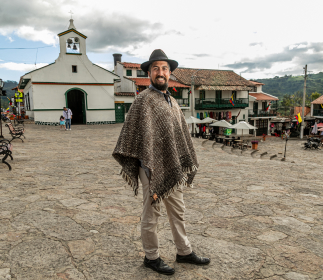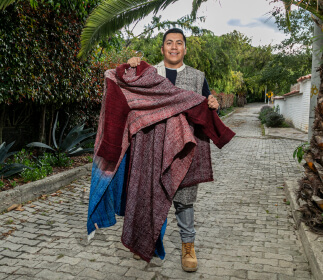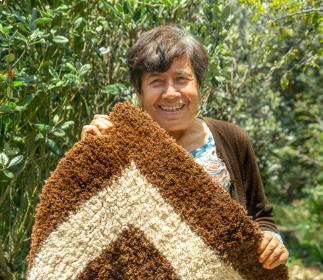Alba Cecilia Tapias Ladino
Workshop: Telar y Tradición
Craft: Tejeduría
Trail: Paipa-Iza and Paipa - Guacamayas Route
Location: Monguí, Boyacá
SCHEDULE YOUR VISIT
Carrera 1 # 7-16 Monguí, Boyacá
3043928145
albactapias@gmail.com
@telar_y_tradicion
You probably have never faced the person who makes your puffy wool blanket at the foot of your chimney, or at the entrance of your country house, or even that heats the rooms with stoneware slabs that abound in Boyacá’s colonial houses. Well, it is time you put a face, a smile, and a history behind those rugs that bring back so many warm memories. Alba Cecilia Tapias has woven them for more than 40 years in Monguí, and, even though she is an authority in the matter and heiress of a family legacy, she wants to make it very clear that what she does comes directly from God’s hands.
Because it was father Alonso Ojeda, the town’s priest back then, who did everything he could to intervene so as many of Monguí’s townsfolk as were willing to learn the trades of woodworking, forging, stone carving, and weaving received training. He sent people to study in Popayán; made agreements with Artesanías de Colombia, the German government, and the town’s Department of Education; established an association of artisans; and gave a large space inside the church for workshops to be set up. The enthusiasm, as it generally does, got a lot of people excited, but only those who persevered won their place in history. Like Alba Cecilia.
It is the most normal thing for her to recount how weaving is something that makes part of daily life of Boyacá’s townsfolk. Because many of them have a small parcel of land, a thicket of esparto straw with which they make baskets and one or two sheep that they know how to shear and whose wool they know how to spin, dye, and weave. But, above all and because of their needs and poverty, they have had to weave their sweaters, ruanas, hats, socks, and blankets with which they escape the cold. Just survival sense.
Thus, at the very beginning of the 1980’s and with 20 vertical looms, the apprentices tasked themselves with trying new things, among which the wool blankets in question can be counted. She likes to mention that these are worked with a double weft, meaning that the first warp is made in cotton on the vertical loom and gets woven with a twist in yarn, which is the one that gets braided together for the wool to tighten. From there, its wool flakes get knotted one by one until they turn into one of those dense rugs, over which it is a bliss to lay down. She also says that a large rug, made up of several other 70 by 70 centimeter-large rugs put together, takes, in the hands of the most seasoned weavers, two ten-work-hour days and four people working nonstop.
Nonetheless, if recounting this careful job produces joy in her, it is enough to witness her talking about her fascination for the art of dyeing the wool that will later decorate our homes to feel her at her best. Her interest was triggered when she discovered that the colors of Monguí’s church came from natural dyes. There, an entire world opened up, and numerous plants with which she has researched wool dyeing over the years started to parade in front of her curious eyes. Lichens, grey eucalyptus, and fig trees for the greens; red berries for the blues; the color —that is how it is called and its root looks like an orchid— for the yellows; the curtidera (Coriaria ruscifolia) for the purples; the roots of the tintórea, the indigo plant, and the sulfur ruby (rejalgar) for the browns. Everything in her has come from years of study, trials, errors, and achievements, as well as from tests to remove undesirable odors from the wool —like the old, stored stench, which is the last thing she wants her rugs to produce—. She likes to know that she has made it, and she knows herself to be a botanist and conservationist: she doesn’t go tearing up plants just because, nor does she deforest. She brings back seeds from her hikes and plants them in her garden to say if they grow.
She enjoys her trade, which has become her life, quite a bit. Weaving is her therapy against stress and her way of sharing amongst mysticism, laughter, stories, and gossip. It is her happy way of life.
Craft

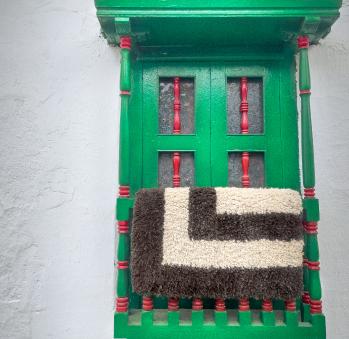



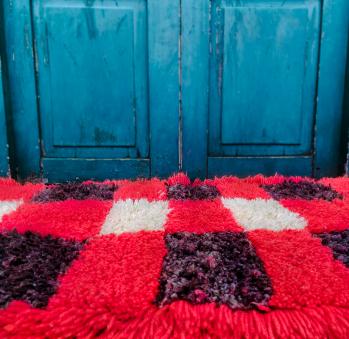






Artisans along the way
Artisans along the way
No puede copiar contenido de esta página






















































